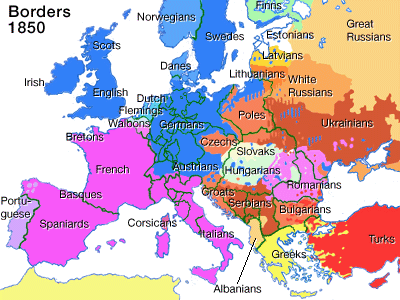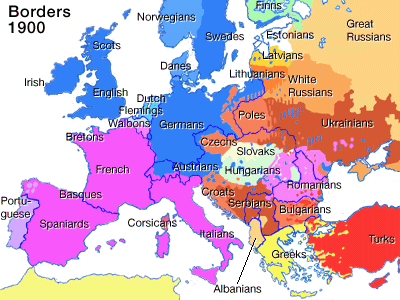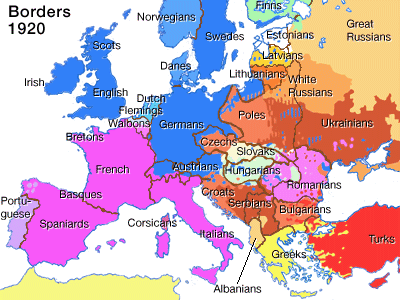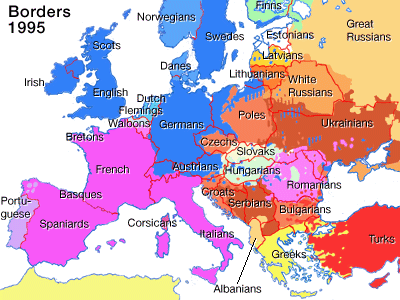Spring semester 1996
Hans L Zetterberg lectures at City University, Stockholm in the course "The European Origin"
The Demography of Europe
About this lecture.
Level: Senior undergraduate, graduate.
This lecture takes population statistics as a starting point for a discussion of contemporary social change in Europe.
The total population 1995 of a broadly conceived Europe (excluding Asian parts of Russia and Turkey) is 690 million. The most spectacular change anticipated for the next two decades is the growth of Turkey to outdistance Germany, Italy, and the United Kingdom as the largest regional population outside of Russia.
The market economy in Europe has slowed down its population growth; the Europeans are at present 12 per cent of the world's population, down from 27 in 1900. Migration driven by economic motives now affects the population changes in Europe as much as the balance of births and deaths. A liberal but orderly process of internal European migration is an emerging responsibility in the wake of the victory of the market economy over the command economy. The prospects for a liberal and orderly external migration into Europe from the Muslim world and from Black Africa remain dim.
The German-speaking Europe contains a new large, fast-growing, unified market of senior citizens who are rich, active, and in good health. The young profile of the population in Eastern Europe is helpful to its current difficult process of change.
The lecture includes a discussion of Europe's ethnic minorities and nation states, a situation which may call for a redefinition of majority rights in European democracy.
Hans L Zetterberg, Professor of Sociology, is responsible for this lecture. You may check his curriculum vitae by clicking on his name.
There is no text book; all reading and viewing material is found on the Web. Tables can be updated annually through The Population Reference Bureau.
Copyright © 1996 Hans L Zetterberg and The City University in Stockholm.
Hans L Zetterberg begins:
The European Continent - What is Inside and Outside?
We consider Europe to be a "continent" out of respect for its history and civilization. In geographical fact, it is no more a continent than, say, India, which in the 1990s has about the same population. Europe is an extension of the great Eurasian land-mass. Its three waterfronts are natural borders: the Arctic Sea in the north, the Atlantic Ocean in the west, and the Mediterranean in the south. The eastern border to Asia is less clear-cut.
It is usually agreed that Europe ends along the Ural mountain range and along the Ural River to the Caspian Sea. For analytical purposes we should divide Russia into one eastern and one western part with the Ural mountain range as the natural divide. This division, unfortunately, has few counterparts in Russian statistics, although for the Russian peoples it may represent a kind of psychological border. As a rule of thumb, somewhat more than two thirds of the Russian population of 148 millions fall within Europe Proper. In our review here we will include the entire Russia in the European statistics; as we lack separate statistics for its European and Asian parts.
Another ambivalence is found in TransCaucasus, that is Armenia, Azerbaijan and Georgia. They are sometimes counted in Europe, sometimes in Asia. We will do the latter. The republics are small. In 1995 Armenia had 3.8 million, Azerbaijan 7.6 and Georgia had 5.4 million.
The geographical divide of the Strait of Bosporous separates Europe and Asia and divides Turkey. Most schoolbooks put Turkey in a special region called Asia Minor, but its geography and economy and politics make Turkey closer to Europe than to Asia. Turkey today is Muslim, but it also has within its borders many remains of ancient Greek culture and it is the spiritual home of the Greek Orthodox tradition of Christianity. Several million Turks, mostly from the eastern regions of the country, have migrated into European countries in recent years, and perhaps one fifth of them have returned to live Turkey after absorbing more or less of the European way of life. This migration pattern has brought Turkey closer to Europe. Turkey's population in 1995 is 63 million of which some 50 million live in geographical Asia.
Europe with Turkey and Russia then has in 1995 a total population of 791 million. The rule of thumb is that Europe without the Asian parts of Russia and Turkey has a about 100 million less, that is to say 690 million.
Europe's Past and Future Population
A European population figure of 690 million people sounds like a very big number. But it is only 13 per cent of the world population.
Population of World Regions 1800-2100
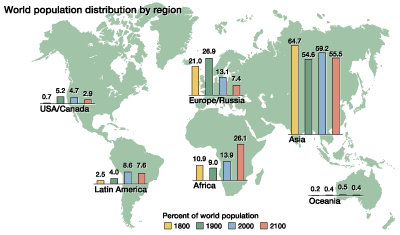
Europe's share of the world population was 21 per cent in the year 1800. It rose to 27 percent in the year 1900 when Europe was at the peak of its power. In the year 2100, Europe's population will be about 7 per cent of the world total.
Whatever aspiration for the world that the Europeans may have for the coming millennium, it will be the aspiration of a small minority. The image of Europe is bound to include exclusive and perhaps privileged qualities rather than universal ones.
The Country Roster
In the mid-1990s Liechtenstein and San Marina, each with 30.000 inhabitants, are the smallest countries in Europe. Russia with a population of 147.7 million, of whom about 100 million live in Europe is the largest.
The dominant country populationwise in the center of Europe is Germany,
which after the unification has 81.7 million inhabitants. Germany is
significant step ahead of the other European powers such as France (58.4),
United Kingdom (58.8), and Italy (57.3). Turkey, however, looms lager than
the latter with a population of 63.9 million. Click on Europe on this map
to see the figures for all countries.
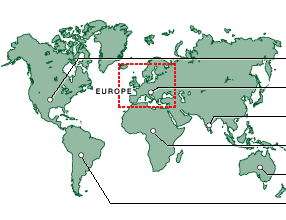 |
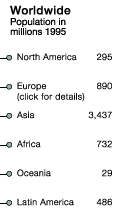 |
The population in the countries in European Union in 1995 comprises 354 million, or 45 per cent of the European total. It is unfair to many millions to speak of the EU as "Europe."
Some Extremes
Europe includes the world's northernmost population concentration that can be counted in millions. It is found in Finland, with a population of 5 million, all living very civilized above latitude 60 north.
A look at a population density map for the world does not single out Europe as a whole as overcrowded. There are exceptionally densely settled countries such as the Netherlands, with 1187 persons per square mile, and Belgium with 866. But the visitor there does not get the sense of city crowding so common in Africa, Asia or Latin America.
Slowing Down Population Growth
Europe has a slower population growth than other continents. A general measure of the rate of population increase is the number of years it takes for a population to double in size. At current growth rates the world's population doubles in 46 years, while Europe's doubles in 445 years. This table shows the doubling rates for the various continents. The numbers come from the Population Reference Bureau in Washington DC, a private organization concerned about population control. They are exaggerated as a prognosis for underdeveloped regions since it is unrealististic, as we soon shall see, to believe that current rates will prevail there.
| Region | Population 1995 | Doubling time in years at current growth rate |
| Africa | 732 | 24 |
| North America | 295 | 93 |
| South America | 486 | 33 |
| Asia | 3437 | 37 |
| Oceania | 29 | 57 |
| Europe | 890 | 266 |
Europe stands out in this table. The slower population growth in Europe has a long history, dating back to medieval times. William Petersen describes it in this way:
Before the development of modern industry, Europe was already distinguished from the other great civilizations by the control that its family system imposed on the rate of population growth. In classical India or China, for example, marriage was all but universal and typically took place at puberty or shortly thereafter. In Europe a quite different pattern evolved, varying from country to country but with certain characteristics common at least to the Western region. Guilds generally did not permit apprentices to take a wife until they had finished their training, and this regulation meant that a substantial portion of the urban population had to postpone marriage for a considerable number of years after it was physiologically possible. In agriculture, numerically the most important sector of the late medieval and early modern economies, farmhands were almost members of a farmer's family, and thus were under no social or economic pressure to marry early. Men were induced to put off assuming parental responsibilities until they had acquired the means to care for a wife and children. This meant in many cases that they never married, but lived as fully accepted members of a household headed by an older brother, who because he had inherited the family plot was able to be a "husband" (which means, literally, householder). As a result of this personally onerous but socially effective system of birth control, Europe's population generally did not press as heavily on the subsistence available to it as in the Asian civilization s; compared with China or India, Europe was relatively free of great famines. And at the beginning of the modern era, the continent was still relatively sparsely populated.
(William Petersen, The Politics of Population, Anchor Doubleday, Garden City, NY, p. 126.)
With the advent of market economies, industrialization, urbanization, education, and modern medicine, death rates in Europe fell, and its population grew rapidly. A generation or two later birth rates also fell, and Europe reached its present status of slow population growth.
Europe shows a pattern of demographic transformation that the rest of the world now follows.
In Europe, the urban population is in the 1990s as high as 74 per cent of the total. In Britain, the oldest industrialized country, it is 90 per cent. In Russia it is 73 per cent. The comparable figures for North and Latin America are 74 and 69 per cent, respectively. They contrast markedly with the Asian figure of 33 per cent urbanites and the African of 31 per cent. Click on Europe to obtain detailed numbers. Or, if you want to read them as a table, click here.
 |
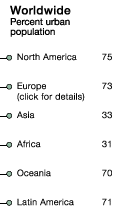 |
A mirror image of urbanization is found in the statistics on agricultural labor. The transformation from an agricultural economy of sustenance to an urban market economy is the key to gross population control. In such an economy both women and men have education and jobs. The desired number of children is balanced by the desired education, the desired job, and the desired living standard and life style.
Most writers think of this transformation from rural life to an urbanized and industrialized life as a seamy process of human degradation. Let us quote from a Nobel laureate who also sees the positive side:
The increase of population . . . stems from the fact that people living on peripheries of market economies, while already profiting from their participation in them (through, for example, access to more advanced medicine, to better information of all sorts, and to advanced economic institutions and practices), have nonetheless not adapted fully to the traditions, morality, and customs of these economies. For example, they still may practice customs of procreation stemming from circumstances outside the market economy where, for instance, the first response of poor people to a slight increase of wealth had been to produce a number of descendants at least sufficient to provide for them in their old age. These old customs are now gradually, and in some places even quickly, disappearing, and these peripheral groups, particularly those closest to the core, are absorbing traditions that allow them better to regulate their propagation. After all, the growing commercial centers become magnets in part just because they provide models of how to achieve through imitation what many people desire.
….Of course it may be hard for some to accept that those living in these shanty towns deliberately chose them over the countryside (about which people have such romantic feelings) as places of sustenance. Yet, as with the Irish and English peasants Engels found in the Manchester slums of his own time, that is what happened.
(F. A. Hayek, "The Extended Order and Population Growth" in The Collected Works of F. A. Hayek, volume 1, The Fatal Conceit, Chicago, University of Chicago Press, 1988, p. 129.)
A Stable Population?
The fact that the world-wide transformation to market economy in time makes for a more manageable population growth is a major cause for demographic optimism. We are not approaching an earth with standing room only. Death rates have everywhere declined for the past two generations. There is little doubt that, beginning with the living generation, the world's birth rate has now entered a period of decline. Eventually, in a market economy, a stable replacement level of fertility is reached when the average woman in her lifetime gives birth to 2.1 children. The rate then goes up or down according to market preferences and the resources of the world.
A market economy is not the only way to achieve population stability but it is the most voluntary way if you have the patience to wait out the course of the process. China has instead an accelerated program that limits the number of children by legislation.
Europe has already achieved the stable level of two children in a women's lifetime As shown in the map below, most European countries are below that level; click the map to read them as a table.
 |
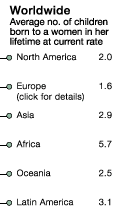 |
Approximately 35-45 years after a 2.1 level is recorded the total
population becomes stationary. At this level, couples merely replace
themselves and do not augment successive generations. If the rest of the
world follows Europe's lead so that the average of two children per women
occurs worldwide by 2040, the world's ultimate population will be some 11
billion. That plateau will be reached by the year 2100. Some demographers
have calculations that end up with a lower final number.
Support of family planning to accelerate the decline is assumed in all the calculations. It is, however, difficult to anticipate the exact future level of contraception, particularly in the Muslim world. It is noteworthy that even the full availability of the best contraceptives in the most educated and secularized nations does not at all seem to suffice to make every pregnancy welcome. Many abortions occur in European countries, particularly in the eastern ones.
Table 3 shows the ten largest populations (in millions) in Europe in
1990 and 2020.
| 1990 | 2025 | ||
| 1. Russia | 1. Russia | 153.1 | |
| 2. Germany | 79.5 | 2. Turkey | 91.8 |
| 3. Italy | 57.7 | 3. Germany | 79.3 |
| 4. UK | 57.4 | 4. France | 63.6 |
| 5. Turkey | 56.7 | 5. UK | 62.5 |
| 6. France | 56.4 | 6. Italy | 54.4 |
| 7. Ukraine | 53.0 | 7. Ukraine | 54.0 |
| 8. Spain | 39.7 | 8. Poland | 34.6 |
| 9. Poland | 37.8 | 9. Spain | 40.5 |
| 10. Romania | 23.3 | 10. Romania | 21.2 |
The growth of Turkey to outdistance Italy, the United Kingdom, and Germany and to have the largest population in Europe outside Russia is the most spectacular change we can anticipate in the Top Ten Population List in the next few decades. Italy drops from third to sixth place in this list.
Several countries besides Germany and Italy can expect declines in populations between 1990 and 2025, for example Denmark, Finland, Ireland, Belgium, Romania, and Portugal.
Europe has also two areas with population doubling rates that are above the world average: Albania and Turkey, both Muslim areas. This map shows doubling times for the continents and for the European countries. Or, if you want to read them as a table, click here
 |
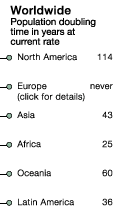 |
We see that a score of countries in Europe will never double their populations, given their present demographic realities.
The Age Structure
Populations with no growth or slow growth get a top-heavy age pyramid, that is, there are more elderly. (See Map 5.) Sweden has a higher proportion over 65 than any other European country; almost every fifth Swede (17 per cent) is 65 or over. The German-speaking countries also show a profile of old age. They constitute the largest market for senior citizens in Europe: about 15 million people over 65, most of them relatively well off, and in good health, and with active life styles. England, France, and Italy also have high proportions of elderly.
Map 5. Over 65 years of age as percent of total population
| Africa | 3 |
| North America | 13 |
| Latin America | 5 |
| Asia | 5 |
| Oceania | 10 |
| Europe | 14 |
| NORTHERN EUROPE | |
| Denmark | 15 |
| Estonia | 13 |
| Finland | 14 |
| Iceland | 11 |
| Ireland | 11 |
| Latvia | 13 |
| Lithuania | 12 |
| Norway | 16 |
| Sweden | 17 |
| United Kingdom | 16 |
| WESTERN EUROPE | |
| Austria | 15 |
| Belgium | 16 |
| France | 15 |
| Germany | 15 |
| Liechtenstein | 10 |
| Luxembourg | 14 |
| Netherlands | 13 |
| Switzerland | 15 |
| EASTERN EUROPE | |
| Belarus | 12 |
| Bulgaria | 15 |
| Czech Republic | 13 |
| Hungary | 14 |
| Moldavia | 9 |
| Poland | 11 |
| Romania | 12 |
| Russia | 12 |
| Slovakia | 11 |
| Ukraine | 14 |
| SOUTHERN EUROPE | |
| Albania | 6 |
| BosniaHerzegovina | 7 |
| Croatia | 12 |
| Greece | 13 |
| Italy | 16 |
| Macedonia | 8 |
| Malta | 11 |
| Portugal | 14 |
| Slovenia | 12 |
| Spain | 15 |
| Serbia, Montenegro | 11 |
| Turkey | 5 |
The large share of elderly are less of a strain on the medical system than most people believe. Medical costs do not rise in proportion to the number of years we live as senior citizens. For most, it is only the very last year of life that entails the high medical costs. And each individual has only one such year.
In Eastern Europe the proportion of the over-65s is much smaller, usually between 5 and 10 per cent of the total population.
A bulge in the number of pensioners will occur around 2010 when the war boom children retire. This will put a severe strain on unfunded public pension systems. Too few of working age will be called upon to pay for the many of retirement age.
The young in Europe (Map 6) are most in evidence in Albania and Turkey, where more than one third of the population is under 15. In Ireland more than a quarter are as young. The nations of Eastern Europe have otherwise the younger populations. This is comforting because they now need all the adaptability of youth. The age structure of Eastern Europe is one of the few causes for optimism about the region.
Map 6. Under 15 years of age as percent of total population
| Africa | 44 |
| NorthAmerica | 22 |
| LatinAmerica | 35 |
| Asia | 32' |
| Oceania | 26 |
| Europe | |
| NORTHERN EUROPE | |
| Denmark | 17 |
| Estonia | 20 |
| Finland | 19 |
| Iceland | 25 |
| Ireland | 25 |
| Latvia | 21 |
| Lithuania | 22 |
| Norway | 19 |
| Sweden | 19 |
| United Kingdom | 19 |
| WESTERN EUROPE | |
| Austria | 18 |
| Belgium | 18 |
| France | 20 |
| Germany | 16 |
| Liechtenstein | 19 |
| Luxembourg | 18 |
| Netherlands | 18 |
| Switzerland | 18 |
| EASTERN EUROPE | |
| Belarus | 22 |
| Bulgaria | 19 |
| Czech Republic | 19 |
| Hungary | 18 |
| Moldavia | 27 |
| Poland | 23 |
| Romania | 21 |
| Russia | 21 |
| Slovakia | 23 |
| Ukraine | 20 |
| SOUTHERN EUROPE | |
| Albania | 33 |
| BosniaHerzegovina | 23 |
| Croatia | 20 |
| Greece | 18 |
| Italy | 15 |
| Macedonia | 24 |
| Malta | 22 |
| Portugal | 18 |
| Slovenia | 19 |
| Spain | 17 |
| Serbia ,Montenegro | 22 |
| Turkey | 33 |
Germany, so rich and successful in other respects, lacks youngsters. Only 16 per cent of the Germans are under 15. It looks as if the Germans have not really believed that their economic miracle would last to include children and grandchildren.
Welfare in Demographic Terms
A long life is a traditional sign of welfare. Life expectancy at birth is 74 years in Europe, 75 in North America, 69 in South America, 52 in Africa, and 63 in Asia. Life in politically underdeveloped societies is no longer "nasty, brutish, and short," as Hobbes said; it is nasty, brutish, and long.
The most widely used demographic measure of welfare is infant mortality. Statistics for infant mortality are readily available for most countries. It has also been found to be highly correlated with more sophisticated measures of general welfare. This clickable map shows North America and Europe leading the world in child welfare.
 |
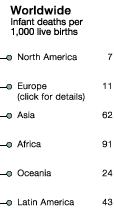 |
Migration
So far we have dealt with the balance between births and deaths as determinant of populations. Historically, this balance has been more important than the balance between emigration and immigration. Yet, Europe may look forward to a period in which migration looms large. In the coming decades, migrations may have a greater effect on the size of population than natural increase. Eleven per cent of the population of France is foreign born; eight per cent of the people in Great Britain are born overseas. These are high numbers by international standards. The traditional country of immigration, the United States, has six per cent residents who are foreign born.
There are push and pull factors in migration. Among the pulls, i.e., the attraction of Europe, is its riches. GNP per capita in Europe was $12,170 in 1994. North America had $19,480 and remains the first choice of the economic migrant. Latin America had $1,930, Africa $600, and Asia $1,430.
The economic map of Europe shows many rich regions and many poor ones, which encourages internal migration. The large economies have a special appeal to young people in the poorer regions. When you look, not at geography and people but at money and the size of the national economies, the map of Europe in BNP-scale in 1994 looks like this:
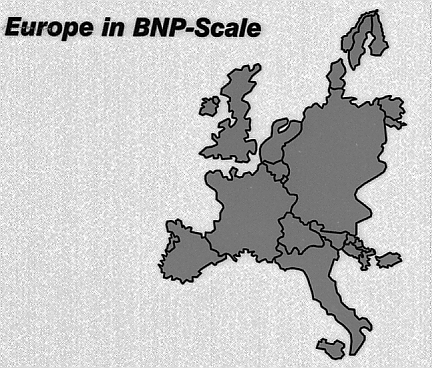
Internal migration
The push factors in internal European migration have in the 1990s become stronger due to the plight of the Eastern European economies. Its typical factory town in Communist days with, say, 60,000 inhabitants and a "combinat" with 4,000 to 10,000 employees during the 1980s used to ship two thirds of its output to the Soviet Union. The managers had little knowledge of the true prices of their raw materials and energy; they lacked firm knowledge of and feedback from the markets of their finished products; they had no knowledge of finance. A ministry in the capital handled everything except the straight production. These factories have now lost most orders from their main customer, the former Soviet Union. Their products do not yet have the sophistication and quality to compete well on the Western markets. It is catastrophic, not only for the factory, but for the whole town.
There are a hundred such towns in Poland, Czechoslovakia, Hungary and throughout the former Comecon block, and many more with other profiles but similar predicaments. They do not have a rich uncle like their counterparts in Eastern Germany. Here a strong push is generated to internal migration in Europe. The young and the educated are the first to move. After the fall of the Berlin Wall in 1989 about two million Europeans have moved from east to west in peak years.
How green is the grass across the fence? How much richer are the people on the other side of the border? Such calculations are easy to make since measures of GNP per capita are available. Some are summarized on the clickable map below.
 |
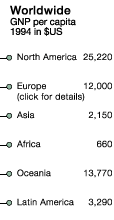 |
An average Finn is 7.1 times richer than his Russian neighbor, an average Swede 10.9 times than the people across the Baltic. A German is 10.4 times richer than a Pole, and 7.9 times richer than a Czech. An Austrian is 6.5 times richer than a Hungarian, and an Italian is at least 50 times richer than an Albanian. You may cheer this as the victory of the market economy over the command economy, but it is a victory with a demographic price and with grave responsibilities. Europe must now strive to attain an orderly process of internal migration.
External migration
The economic forces driving external migration into Europe from North Africa are practically as strong as the forces driving the well-known migration across the Rio Grande in America. The average US citizen is 10.9 times richer that the average Mexican. The Arabs in Morocco, Tunisia, and Algeria who move to the nearest countries across the Mediterranean are pulled by the fact that the Spaniard is 10.3, the Frenchman is 6.6 and the Italian is 10.8 times richer there than the average citizen in their respective old home lands.
South of the Sahara is Africa's most populous nation, Nigeria, with 119 million inhabitants 1995 but with an anticipated population of 273 million in 2020, making Nigeria a larger country than any European. These numbers are a reminder that in a longer perspective Europe faces a much stronger immigration pressure from Black Africa.
The immigration to Europe will increasingly come from Islamic areas. A Muslim world of high fertility surrounds much of the European peninsula with its low fertility. The Muslims of the world will soon number one billion people. Their doubling time is 25 years. Most Muslims live in eastern Asia. Thus, Europe is not the only target for the population pressure from the Islamic world.
We cannot lock out all the poor peoples at our gates, nor can we encourage racism and xenophobia by permitting unlimited immigration. The free movement of people across the internal borders of the EC is a cornerstone of the European Community. The prospects for a liberal internal migration within the entire Europe are at best fair; the prospects for a liberal external immigration are very dim.
The Nationalities of Europe
Europe has hundreds of ethnic minorities ranging from the Lapps of the north (the only nomadic people in Europe) to the Welsh in the west, the Ukrainians in the East, and the Andalusians in the south.
Europe does not assimilate its ethnic groups as the United States does. There is no "European Creed" that commands the loyalty of the various Europeans as the "American Creed" commands the loyalty of US citizens of different ethnic backgrounds. To be "un-European" is merely to be different or odd, while to be "un-American" is to be a traitor to the creed.
The map of the major European nationalities has not changed much in the last 100 years. Stalin did move some people around. Some smaller groups have assimilated or moved, for example, the Swedes in Estonia. Many ethnic Germans in eastern Europe have moved home. But in the main, we have no difficulty in recognizing the distribution of nationalities in Europe at the end of the twentieth century from their distribution at the beginning of the twentieth century. There are still the Turks in Bulgaria and the Hungarians in Romania, to mention two hot items in today's news. A map from The Times Atlas of World History gives details from the year 1900.
The Enlightenment of the 18th century embraced the idea that ethnic differences are unimportant compared to the common human heritage the destiny of which is a universal civilization. In the same vein, when nationalism became rampant in the 19th century, many saw it as mere tribalism revived and written large. This view is too superficial to political science and sociology.
Ethnicity became a major political force. During the past 150 years, as a result of wars and of political negotiations, the national borders in Europe have changed into greater conformity with the major ethnic groupings . Study the series of maps illustrating this central phenomenon of European history in modern times. The background to all maps is the ethnic distribution in 1900.
Behind the political force of nationalism lies a sociological fact that the belonging to a given (maybe in some measure constructed) community, with given ties of language, traditions, historical memories (true or false), creates a strong social identity. To deny people this identity is a serious deprivation, perhaps as serious as depriving them of shelter and freedom of movement. Whether we like it or not, to celebrate ethnicity is more natural for mankind than to celebrate faith in reason.
True, you can yourself choose to suppress your ethnic identity. If you shake off your ethnic ties to become a cosmopolitan, others may nevertheless remember your background. In one of the most tragic periods of recent European history, all Jews, even the most collaborating, or secularized, or nationally integrated, or cosmopolitan, were Jews in the eyes of the ruling Nazis.
The Problems of Multi-Ethnic States
Can multi-ethnic states survive in Europe in our times? The track record for the past 150 years is poor. Europe's two most multi-ethnic states, the Soviet Union and Yugoslavia, have recently collapsed. In Bosnia, the Dayton peace accord of 1996 calls for a multiethnic state, but the voters support parties that want separate states. Czechoslovakia has peacefully split along ethnic lines. Switzerland, by contrast, does very well. We also see achievements in Finland, and progress on crutches in Belgium.
Perhaps the rest of Europe can learn something from Switzerland, our most successful federation. Within the Swiss state, the Germans, French, Italians, and Romanos can remain separate peoples. The Germans constitute about 70 per cent of the Swiss. If the country were a simplistic democracy, this German majority would always rule. Ethnic conflicts would then be the order of the day. The French would secede and declare independence, perhaps also the Italians.
There is a built-in conflict between democratic majority rule and the aspirations held by unassimilated ethnic minorities. Switzerland has solved this conflict by federating cantons most of which are ethnically homogeneous.
The solution to an ethnic conflict is not found in the attitude of the minority to the state, but must be found in the attitude of the majority. Brutally put, the majority must not exercise its full democratic rights! The majority ethnic group must make clear to the minority that the minority is so valuable that it has the same rights as the majority, and preferably even greater rights than the majority. A multi-ethnic federation will work best when the minority feels that it gets more than its proportional share of the bonanzas of the federated state.
Outright celebrations of ethnicity in a multi-ethnic society should be confined to the private sector; to promote them with federal funds may be as divisive as promoting a special religious faith with tax money. Taxes should be low so that civil society will retain resources for ethnic pursuits in the form of museums, song festivals, literature and art, et cetera.
Henry Steele Commager, the American historian, maintains that no form of government is as difficult as the federation. He thinks of the success of federation in the United States as a greater achievement than Pax Americana. He thinks the federation entails more of a complicated process than the creation of American prosperity. Even on American soil, federation has been problematic. The union split over slavery into civil war. The federation created by the southern states did not survive.
We have to develop European democracy to cope with multi-ethnic territories. Today democracy represents the right of the majority to rule over an ethnic minority. Tomorrow it must also be some rights for the ethnic minority to be protected from the rule of the majority. Then, the prospects of European federations will be auspicious.
Here ends the lecture. Thank you for your attention!
The lectures in this course "The European Origin" at City University on Stockholm
Professor Hans L Zetterberg on " The Historical Differentiation of the European Institutional Realms".Professor Teddy Brunius on " European Art: From the Medieval to Modern Times".
Ambassador Lars Bergquist on " The finger of God: European Catholicism and Wordly Power".
Cand. Phil. Birgitta Kurtén Lindberg on " Problems of Democracy in Classical Athens: Ours as Well?".
Professor Anders Fogelklou on " How the Constitution Ordered the European Freeedom".
Professor Ulf Bernitz on " European Community Law".
Professor Lars Gustafsson on " The Creative Impulse in its European Setting".
Professor Leonard P Liggio on " European freedom: a special case".
Professor Hans L Zetterberg on " The Demography of Europe".
